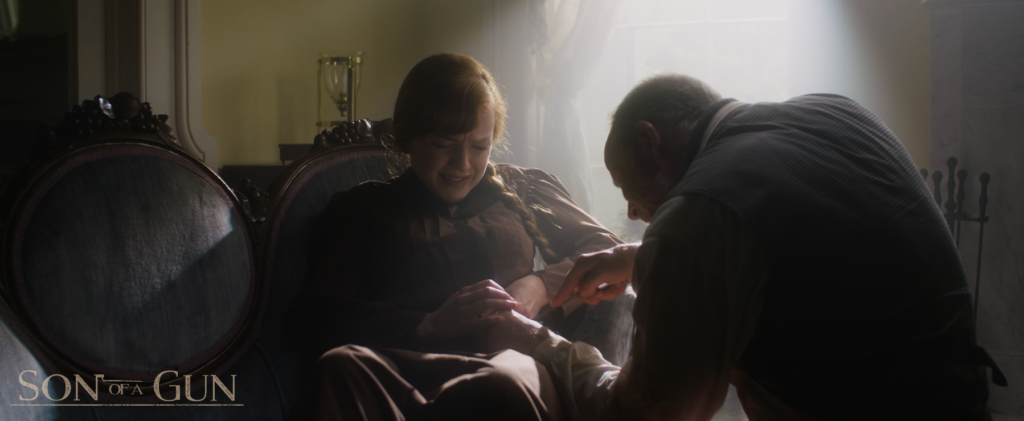This begins the final series of blog articles I’ll be writing along with First Time in a Movie and Community that track the production history and experiences we had on our latest film Son of a Gun. Director’s Notes will focus specifically on my thoughts about our movie and the making of it as I process them over the next few months.
Director’s Notes: Three Movies in One
Though we’ve hinted at it here and there, we haven’t spelled out the fact that Son of a Gun has not one but three versions of the same story in its narrative. When I first stumbled on the tall tale of the minie ball pregnancy, two things immediately had me by the creative balls so-to-speak: 1. The character of Legrand Capers, the doctor who propagated the myth, and the question of why he might do so. 2. The possibility of exploring the “truth” behind stories and why our history so often changes over time or from whose perspective its being told.
From there came the idea to show different versions of the bullet pregnancy myth, which if you don’t know already involves a supposed bullet which was fired during a Civil War battle, passed through a soldier’s scrotum, and imbedded itself in a young woman’s womb causing her to bear the wounded warrior’s child. So many questions came to mind when I first read this tale online. These inquiries prompted the three versions you’ll see in Son of a Gun. I can’t share them all without revealing too much of our movie but let’s just say the quest was to explore what might have been the truth behind this fantastic story.

This screenshot from our movie shows actor Miles Doleac as doctor Legrand Capers and Lindsay Anne Williams as the wounded woman.
What I really want to touch on in this article however are some of the ways that this concept of three movies in one developed through the process of making Son of a Gun. Even when writing the first draft of the script, I imagined some of the differences between the three stories: each would have a different visual style, each would feature a different actor/actress playing some of the supporting characters such as the soldier who is shot or the mother of the wounded girl, and of course each version would have some surprise twists and turns that the previous one did not.
However, this concept really took hold as we drew closer to our production start date. I remember the first meeting with director of photography Nicholas Fornwalt at DeFalco’s Italian Deli in Scottsdale, Arizona. At that point it was unclear just how much would be different would be change between the three iterations of the myth but we both agreed it would be best to keep our principal characters the same throughout. A couple months later, this changed; I called him to declare that I felt even the lead characters, doctor Legrand Capers and the house servant Mamie, should be played by different actors throughout the film. It was a bold move, we agreed, but making independent films is all about taking chances and trying new things. I strongly felt (and still do) that this decision will work for our audience, differentiating from the stories and perspectives of our narrative.

As you can see, this screenshot shows a similar but different scene as the one above with Shannon Williams as Legrand Capers and Holly Bonney as the injured girl. It is also filmed at Canemount Plantation Inn whereas the previous one was shot as Rosswood Plantation.
One of the biggest elements of the “three movies in one” idea came to us by accident. Orson Welles once said, “The absence of limitations is the enemy of art,” and this philosophy has prevailed throughout the existence of Running Wild Films. One of the prime examples of how right Orson was came mere weeks from the start date of Son of a Gun. Originally, we wanted one plantation home to be featured as the center of our film. This would be the location in all three stories where the girl is shot and much of the dramatic action of the movie takes place. We pitched our shoot dates to the owners of a gorgeous plantation home near Port Gibson and unfortunately (or in truth, fortunately) they could not accommodate the full time span. This prompted the notion to have three houses (Rosswood, Canemount and Collina plantations, all B&Bs now) featured in the film, one for each version of the story. Again, though we felt it was a risky decision, we went for it and I believe this was the final piece that brought together the vision for Son of a Gun.
There is much more to write about how we conceived the three movies in one, including our nicknames for the visual representation of each version which included such intentionally pretentious labels as Tableau, Kinetic and Distressed. Perhaps I’ll explore those in a future article or they will without a doubt end up on the DVD’s commentary track. For now, I’ve probably told you too much! Till the next time…
-Travis Mills



I can hardly wait to see the film!